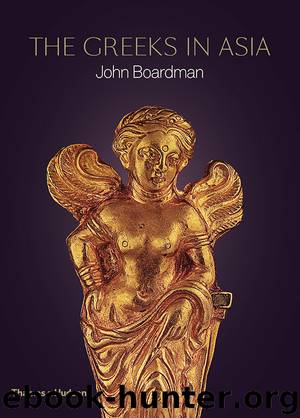The Greeks in Asia by John Boardman

Author:John Boardman
Language: eng
Format: epub
ISBN: 9780500772782
Publisher: Thames & Hudson
Published: 2015-10-03T16:00:00+00:00
The Mauryans and Buddhism
Although the Mauryan dynasty had centred on the Ganges Valley, its rule and activity extended well to the north, into Gandhara and areas permeated by Greeks. Its first king was well known to the Greeks as Sandracotta (Chandragupta) – and according to Indian sources he had been assisted to power by Greeks (‘Yavana’). Its third king Asoka (reigned 268–232 BC) converted to Buddhism and this occasioned the creation of new monuments of architectural and sculptural importance. The ‘stupas’ are a major source: domed structures meant to house relics of the Buddha and surrounded by a walkway with monumental gates and steps lavishly adorned with relief sculpture, highly colourful originally. We shall learn more about the Buddhist stupa shrines with the Sunga dynasty, but Asoka especially celebrated his reign by the erection of single stone pillars on which his edicts were inscribed, placed all across north India; his maxims, some hold, were not without the influence of those of Greek origin, such as were displayed at Aï Khanoum.262 We have already noted his bilingual rock inscription at Kandahar. The pillars are crowned by baluster capitals which may look somewhat Achaemenid (like Persian bases) but are more probably a translation into stone of wooden pillars with cushion tops designed to support tentage, and they are well endowed with varieties of Greek floral friezes.263 But they are also crowned by sculptures of a type without Indian precedent. A zebu bull is an eastern creature but here (on the Rampurva pillar) carved realistically [68].264 The Sarnath pillar top (now the Indian national symbol) [PL. XXXVII]265 is crowned by three seated lions whose semi-realism and box-like muzzles have more Hellenistic/Persian about them than anything in preceding local art, and the relief animals in panels beneath them are pure Greek in style, while the relief friezes of lotus and flame-palmettes could hardly be more Hellenistic. It was perhaps these pillars that Strabo (3.5.6) or Apollodoros (3.5.2) found attributed to Dionysos or Herakles, and allegedly inscribed with their deeds.
Download
This site does not store any files on its server. We only index and link to content provided by other sites. Please contact the content providers to delete copyright contents if any and email us, we'll remove relevant links or contents immediately.
| Africa | Americas |
| Arctic & Antarctica | Asia |
| Australia & Oceania | Europe |
| Middle East | Russia |
| United States | World |
| Ancient Civilizations | Military |
| Historical Study & Educational Resources |
The Sympathizer by Viet Thanh Nguyen(4098)
The Rape of Nanking by Iris Chang(4025)
World without end by Ken Follett(3347)
Ants Among Elephants by Sujatha Gidla(3282)
Blood and Sand by Alex Von Tunzelmann(3061)
Japanese Design by Patricia J. Graham(3006)
City of Djinns: a year in Delhi by William Dalrymple(2438)
Foreign Devils on the Silk Road: The Search for the Lost Treasures of Central Asia by Peter Hopkirk(2389)
Inglorious Empire by Shashi Tharoor(2349)
The Queen of Nothing by Holly Black(2326)
India's Ancient Past by R.S. Sharma(2307)
In Order to Live: A North Korean Girl's Journey to Freedom by Yeonmi Park(2305)
Tokyo by Rob Goss(2295)
India's biggest cover-up by Dhar Anuj(2251)
Tokyo Geek's Guide: Manga, Anime, Gaming, Cosplay, Toys, Idols & More - The Ultimate Guide to Japan's Otaku Culture by Simone Gianni(2244)
The Great Game: On Secret Service in High Asia by Peter Hopkirk(2231)
Goodbye Madame Butterfly(2164)
Batik by Rudolf Smend(2010)
Living Silence in Burma by Christina Fink(1988)
